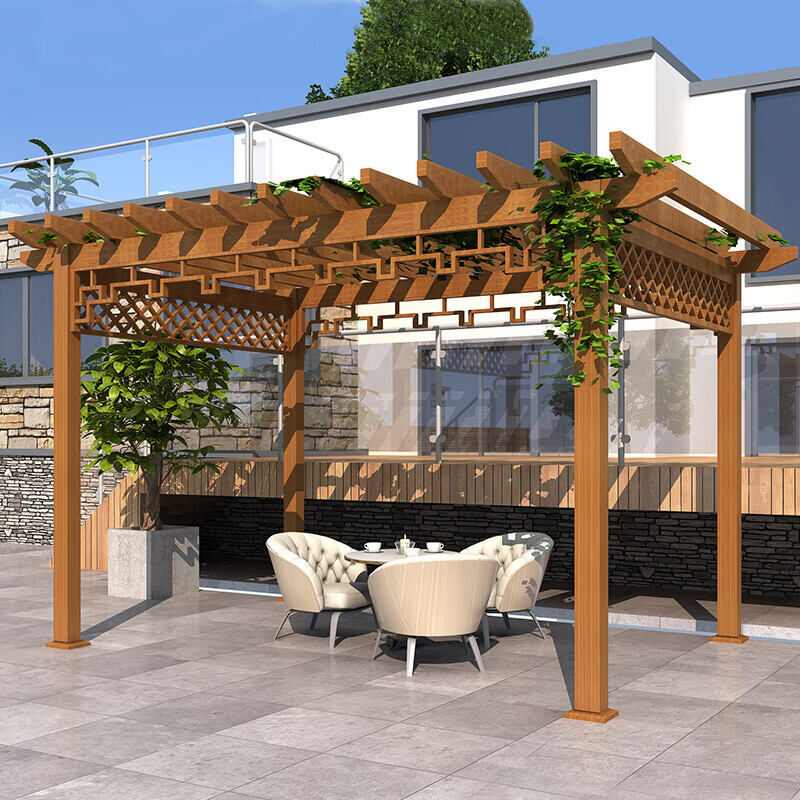Why Choose an Aluminum Grape Trellis for Your Garden?
Lightweight Advantage for Easy Installation
Choosing an aluminum grape trellis offers significant advantages in terms of lightweight and ease of installation. Unlike heavier materials such as wood or iron, aluminum is notably lighter, which simplifies the handling and installation process. This lightweight characteristic minimizes the requirement for heavy-duty construction equipment, empowering DIY enthusiasts to set up their trellis without professional assistance. Studies indicate that utilizing a lighter framework like aluminum can reduce installation time by up to 30%, allowing gardeners to dedicate more time to planting and maintenance tasks. Opting for aluminum makes the setup process more accessible and efficient, ensuring a smoother gardening experience.
Rust-Proof Longevity in All Weather
The rust-proof nature of aluminum makes it an ideal choice for trellises, offering longevity under all weather conditions. Unlike steel or untreated wood, aluminum is not susceptible to rust or corrosion, which ensures a longer lifespan. It effectively withstands moisture, ultraviolet rays, and varying weather conditions without degrading, as supported by material analysis from gardening experts. Manufacturers report that investing in an aluminum trellis can provide over 20 years of service life, significantly reducing the need for replacements. The weather-resistant properties of aluminum not only preserve the structural integrity of the trellis but also offer gardeners a lasting solution for their grape cultivation needs.
Low-Maintenance Durability Over Time
In terms of durability and low-maintenance, aluminum trellises are far superior to other material options. Aluminum requires minimal upkeep, which is perfect for gardeners with busy schedules. Cleaning usually involves simple periodic rinsing with water and mild soap, unlike wood structures that might necessitate staining or sealing. Research highlights that maintenance costs for aluminum structures are considerably lower due to their resilience and strength. By choosing aluminum, gardeners can enjoy a reliable and sturdy trellis that remains robust over time without demanding extensive care, ensuring a focus on gardening rather than routine maintenance chores.
Design Versatility: Matching Your Garden Aesthetic
Modern & Sleek Aluminum Styles
Aluminum trellises offer modern and sleek designs that seamlessly complement contemporary garden aesthetics. Featuring clean lines and minimalist forms, these trellises can significantly enhance the visual appeal of any garden setting. Whether you opt for a geometric pattern or a simple linear design, aluminum trellises can add a touch of sophistication. Moreover, manufacturers provide customization options, enabling you to choose unique finishes and coatings. This allows the trellis to match personal tastes while maintaining the modern aluminum styles that align with current garden design trends.
Rustic Charm with Customizable Finishes
For those who prefer a timeless look, aluminum trellises can be finished with rustic elements to exude antique or vintage charm. This adaptability makes them perfect for country garden settings where they blend naturally with the environment. Custom powder-coated finishes offer creative flexibility, ensuring that the trellis harmonizes with the existing landscape. Expert landscapers often recommend using rustic elements to introduce warmth and character into gardens, effectively turning an aluminum trellis into a bespoke garden feature.
Maximizing Space with Vertical Growth
Aluminum trellises are particularly designed to support vertical growth, an effective strategy for optimizing limited gardening space. By encouraging plants to grow upwards, vertical gardening techniques can increase yields significantly—up to 50% in some cases—making this method ideal for urban gardens, small backyards, or even patios. This approach not only maximizes space but also enhances air circulation and sunlight exposure. Consequently, it fosters healthier plant growth and reduces disease risks, proving to be a highly efficient gardening solution.
Step-by-Step Installation Tips for Stability
Securing the Trellis Base for Wind Resistance
Properly securing the base of a trellis is essential to ensure stability and withstand strong winds. One highly recommended approach is using concrete footings, as these can significantly enhance the robustness of the trellis. According to gardening experts, the base depth should reach at least one foot, providing a solid anchor point. Moreover, in areas prone to high winds, incorporating cross-bracing can offer additional support and durability. These steps not only secure the stability of the trellis but also help prevent disasters such as toppling, which could damage plants or structures nearby.
Training Vines for Optimal Growth Patterns
Training vines on a trellis requires careful techniques to guide their growth and maximize fruit production. Experts suggest starting this process early in the growing season. By tying the vines strategically, gardeners can ensure that the plants adhere well to the trellis structure, promoting healthy and sturdy growth. This practice helps in evenly distributing the vines, which in turn prevents overcrowding—an issue that could otherwise stifle plant development and compromise fruit quality. Consistent monitoring and adjustment of vines as they grow ultimately contribute to a successful and thriving garden pattern.
Seasonal Adjustments for Plant Health
Seasonal adjustments are crucial to maintain plant health and ensure optimal growth conditions throughout the year. One adaptation involves repositioning the trellis to ensure adequate sunlight access tailored to seasonal changes. Experts emphasize the importance of monitoring plant health to determine if any height adjustments to the trellis are necessary. This vigilant approach helps prevent plant stress and supports the overall health and productivity of grapevines. Proactively adapting the trellis setup seasonally not only maximizes plant health but also aids in optimal growth and fruit production cycles.
Long-Term Care for Your Aluminum Trellis System
Cleaning Without Damaging the Surface
Regular cleaning of your aluminum trellis is essential to keep it looking its best and to maintain its integrity. Begin by simply rinsing the trellis with water to remove accumulated dust and debris. Avoid harsh chemicals as they may erode the aluminum surface over time. Instead, experts suggest using a non-abrasive cloth paired with a mild detergent for effective cleaning while preserving the material's finish. Research indicates that consistent upkeep like this can notably extend the aesthetic life of your aluminum trellis, even in areas with challenging climates. By incorporating these easy maintenance practices, you can ensure your trellis remains a sturdy and attractive element of your garden.
Pruning Techniques for Healthy Vines
Effective pruning is crucial for promoting the healthy growth and productivity of vines on your trellis. Techniques can differ significantly depending on the variety and growth habits of the vines. It's essential to follow a strategic pruning schedule to avoid over-pruning, which could stress the plant and inhibit fruit yield. Consulting local extension services can provide valuable insights, offering expert advice tailored to your specific climate and plants. By prioritizing these best practices in pruning, gardeners can cultivate vibrant, healthy vines that beautifully complement the aluminum trellis structure and maximize the output of fruits and flowers.
Inspecting for Wear and Tear Annually
Conducting annual inspections of your aluminum trellis is a proactive measure to ensure its longevity and efficacy. These inspections should include checking for signs of rust or structural damage, which can indicate potential problems if left unaddressed. Experts recommend scrutinizing all bolts and connections for any loosening or corrosion, as addressing these issues promptly can prevent further degradation. By scheduling regular evaluations, you maintain the trellis in peak condition, allowing it to support your plants effectively and ensuring it remains a reliable and long-lasting fixture in your garden.
FAQ
What are the main advantages of using aluminum for grape trellises?
Aluminum trellises are lightweight, rust-proof, and require low maintenance, making them ideal for gardens. They offer durability and longevity under various weather conditions.
How does aluminum compare to other materials like wood and iron?
Unlike wood and iron, aluminum is lighter and doesn't require heavy-duty equipment for installation. It is also resistant to rust and corrosion, ensuring a longer lifespan and less frequent replacements.
Can aluminum trellises be customized to match garden aesthetics?
Yes, aluminum trellises can be customized with various finishes and styles to match contemporary or rustic garden aesthetics, offering creative flexibility and personalization options.
What are the key maintenance practices for aluminum trellises?
Regular cleaning with water and mild detergent avoids surface damage. Inspecting connections annually ensures structural integrity, while pruning helps maintain healthy vine growth.
Are aluminum trellises suitable for vertical gardening?
Yes, they are ideal for supporting vertical growth, optimizing limited space, and improving air circulation and sunlight exposure, which fosters healthier plant growth.
Table of Contents
- Why Choose an Aluminum Grape Trellis for Your Garden?
- Design Versatility: Matching Your Garden Aesthetic
- Step-by-Step Installation Tips for Stability
- Long-Term Care for Your Aluminum Trellis System
-
FAQ
- What are the main advantages of using aluminum for grape trellises?
- How does aluminum compare to other materials like wood and iron?
- Can aluminum trellises be customized to match garden aesthetics?
- What are the key maintenance practices for aluminum trellises?
- Are aluminum trellises suitable for vertical gardening?

 EN
EN








































